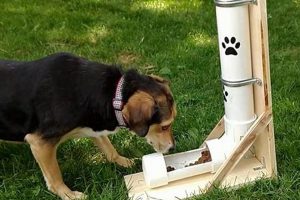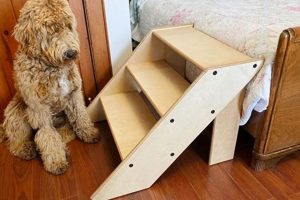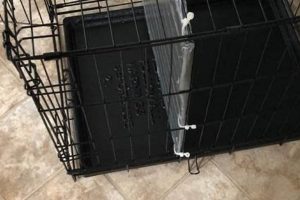A designated space for canines to relieve themselves, constructed by the owner, offers a controlled environment for waste elimination. This involves creating an outdoor or indoor location using materials readily available and assembled by the dog owner, rather than purchasing a pre-made product. Examples include a fenced-off section of the yard filled with gravel or artificial turf, or an indoor tray lined with absorbent pads.
Establishing a defined spot provides several advantages. It aids in housebreaking, reduces unwanted messes inside the home, and simplifies waste management. Historically, owners relied on unstructured outdoor spaces; however, the increasing trend of smaller living areas and concerns about environmental impact have propelled the adoption of these localized solutions.
The following sections will explore the considerations for construction, materials, maintenance, and training aspects necessary for establishing a successful and effective canine waste management solution, tailored to the needs of both the dog and the owner’s living situation.
Construction Recommendations
Effective implementation requires careful planning and execution. Attention to detail in the design and construction phases will yield a more sanitary and easily maintained waste solution.
Tip 1: Location Selection: Prioritize a site that is easily accessible for the dog, yet distanced from living and food preparation areas. Consider proximity to water sources for cleaning purposes.
Tip 2: Substrate Choice: Select a substrate appropriate for the dog’s size and preferences. Options include gravel, artificial turf, wood chips, or soil. Ensure proper drainage is incorporated into the design.
Tip 3: Containment Measures: Implement a physical barrier to define the perimeter. This may involve fencing, edging, or the construction of a raised bed to contain the substrate and prevent runoff.
Tip 4: Drainage Considerations: Adequate drainage is crucial to prevent the accumulation of stagnant water, which can lead to unpleasant odors and bacterial growth. A slight slope or drainage system should be incorporated.
Tip 5: Size Determination: The dimensions of the space must be proportional to the size of the dog. A larger dog requires a correspondingly larger area to comfortably maneuver and relieve itself.
Tip 6: Accessibility Features: For elderly or mobility-impaired dogs, consider incorporating ramps or shallow steps to facilitate access to the designated space.
Tip 7: Regular Maintenance: Establish a routine cleaning schedule to remove solid waste and disinfect the area. This will minimize odors and maintain a sanitary environment.
Adherence to these recommendations ensures the creation of a functional and hygienic solution, promoting both canine comfort and owner convenience. Proper planning prevents common pitfalls and ensures long-term usability.
The subsequent sections will discuss suitable materials and training strategies to optimize the effectiveness of the constructed waste management solution.
1. Location
The selected location is a primary determinant of success in establishing a dedicated canine relief area. The area’s functionality, sanitary characteristics, and ease of maintenance are directly influenced by its placement. For instance, a position adjacent to a doorway facilitates convenient access for the dog, promoting consistent usage. Conversely, proximity to living areas can lead to odor transmission, necessitating robust cleaning protocols and ventilation considerations. Placing the area far from the house might discourage the dog, especially during inclement weather or for canines with limited mobility, resulting in accidents elsewhere.
Practical application involves balancing canine needs with owner convenience and environmental factors. An example is an urban setting where a balcony might be utilized. In such cases, waterproofing and drainage become paramount to prevent property damage and maintain sanitary conditions for neighbors. Conversely, a suburban yard allows for ground-level installations, where soil composition and natural drainage patterns influence substrate selection and the potential need for supplemental drainage systems. Exposure to sunlight also affects bacterial growth and odor levels; shaded areas may require more frequent cleaning and disinfection.
In summary, location is not merely an afterthought but an integral component. Its consideration must precede construction and material selection. Challenges such as space limitations, climate conditions, and potential for odor nuisance necessitate careful planning and compromise. The ultimate goal is to establish a spot that encourages proper canine waste elimination, minimizes environmental impact, and aligns with the lifestyle of both dog and owner.
2. Materials
The selection of materials directly impacts the functionality, hygiene, and longevity of a self-constructed canine waste area. The substrate, containment structure, and any associated drainage components form the foundational elements of the system. Each material choice presents trade-offs regarding absorption, odor control, ease of cleaning, and environmental impact. For example, gravel provides superior drainage compared to soil but can be difficult to clean effectively. Artificial turf offers a visually appealing and easily sanitized surface, but its initial cost is higher, and proper drainage installation is critical to prevent odor build-up. The structural integrity of the containment, whether constructed from wood, plastic, or metal, dictates its resistance to weathering and potential damage from the dog. The materials employed directly cause variation in the practical success of the constructed facility.
A practical illustration of this connection is observed in indoor solutions. Absorbent pads, while convenient, require frequent replacement and contribute to landfill waste. Alternatively, washable fabric pads reduce waste but demand regular laundering. The container holding the pad, typically plastic, needs to be durable and easily disinfected to prevent bacterial growth. A real-world scenario involves a dog owner who initially opted for inexpensive gravel, only to find the constant odor and cleaning difficulties unsustainable. Switching to artificial turf, coupled with an enhanced drainage system, resolved the odor issue and improved maintenance efficiency. This demonstrates the iterative process of material selection based on practical experience and the dog’s specific needs.
In conclusion, material selection is not a superficial consideration but a core component of effective canine waste management. The interdependence between substrate, containment, and drainage necessitates informed decision-making. Although various materials exist, their suitability depends on the owner’s budget, the dog’s preferences, and the intended location. Overlooking these considerations leads to increased maintenance, odor issues, and potential health concerns. Careful selection promotes a sanitary and user-friendly area for the dog, while simultaneously simplifying the owner’s maintenance responsibilities.
3. Drainage
Effective drainage is an indispensable component of any constructed canine waste elimination zone. Its absence directly correlates with increased odor, bacterial proliferation, and potential environmental contamination. The accumulation of urine and rainwater within the confines of the area creates a breeding ground for microorganisms, leading to unpleasant smells and posing health risks to both the dog and the surrounding environment. Conversely, properly implemented drainage systems channel liquids away from the surface, minimizing contact with the substrate and reducing the opportunity for bacterial growth. The selection of drainage method is affected by the substrate, materials, size, and location. The correct drainage mechanism is absolutely vital to ensure a hygienic system.
Practical examples highlight the significance of this element. A canine area utilizing gravel substrate without underlying drainage fabric inevitably leads to the saturation of the soil beneath. This saturated soil becomes a reservoir for urine, resulting in persistent odors that are difficult to eliminate, even with regular cleaning. Likewise, the installation of artificial turf atop an impermeable surface without adequate drainage channels results in water pooling, fostering mildew growth and rendering the surface slippery and unusable. In contrast, constructing a sloped base with a perforated drainage pipe embedded beneath the substrate allows liquids to flow freely away from the active area, maintaining a cleaner and more sanitary environment. The slope should be just enough to drain efficiently and to prevent water from puddling. To achieve a sanitary solution, proper drainage techniques need to be implemented.
In conclusion, drainage represents a critical control point for long-term functionality of any canine relief setup. The cost associated with adequate drainage solutions pales in comparison to the effort involved in mitigating the consequences of poor drainage. Prioritizing drainage during the design phase, selecting appropriate materials, and implementing proper installation techniques ensures a cleaner, more sanitary, and environmentally responsible solution, promoting both canine well-being and neighborhood harmony. Poorly drained DIY systems are ineffective and may pose health hazards to the animal, and the people who live in the household.
4. Containment
Containment establishes the physical boundaries of a designated canine waste elimination area. It is a foundational element which directly affects the area’s functionality, hygiene, and integration into the surrounding environment. Without effective containment, the intended benefits of a localized canine relief spot are compromised, leading to unsanitary conditions and potential conflicts within shared living spaces.
- Physical Barrier Integrity
The physical barrier defining the perimeter must be robust enough to withstand the dog’s size, breed, and digging tendencies. Flimsy fencing or edging is ineffective, as it can be easily breached, allowing waste to spread beyond the intended area. For example, a sturdy wooden fence or concrete border is essential for larger, more active breeds. Conversely, smaller dogs may be adequately contained by lower, less substantial barriers.
- Waste Confinement and Sanitation
Containment directly impacts waste management and sanitation. Properly constructed borders prevent the dispersal of solid waste and contaminated runoff into surrounding soil, landscaping, or living spaces. This is particularly crucial in urban environments where space is limited, and sanitation regulations are stringent. An example would be a raised bed design with impermeable lining to prevent leaching into the ground.
- Delineation and Training Reinforcement
Containment serves as a visual cue for the dog, reinforcing the designated area for waste elimination. Consistent boundaries aid in training, as the dog learns to associate the physical space with the act of relieving itself. This is achieved through positive reinforcement techniques and consistent guidance, creating a clear understanding of the acceptable zone. For instance, consistently guiding the dog to the contained area during potty breaks.
- Aesthetic Integration
While functional, containment should also integrate aesthetically into the surrounding environment. The choice of materials and design should complement the existing landscaping or architectural style. An example would be using natural stone edging to blend with garden features, or using aesthetically pleasing panels.
These facets illustrate the multi-faceted role of containment in creating an effective canine waste elimination solution. Effective construction balances the need for physical security, sanitation, training reinforcement, and aesthetic harmony. The resulting structure ensures the effective execution of canine waste management. The materials used should be durable, easy to clean, and resistant to weathering.
5. Maintenance
Maintenance is an essential, ongoing aspect of a self-constructed canine waste area, impacting sanitation, odor control, and the long-term usability of the facility. Regular maintenance prevents the accumulation of waste, mitigates the spread of harmful bacteria, and contributes to a more pleasant environment for both the dog and owner. A neglected area quickly becomes a source of unpleasant odors, attracting pests and potentially exposing the dog to health hazards.
- Waste Removal and Disposal
The consistent removal of solid waste is paramount. Frequency depends on the size of the dog and the area’s usage, but daily removal is generally recommended. Waste should be disposed of in accordance with local regulations, typically involving sealed bags placed in designated refuse containers. Failure to remove waste promptly results in odor build-up and attracts flies and other pests, compromising the overall hygiene of the surrounding environment. Consider biodegradable bags for waste. Avoid flushing solid waste down toilets, as this can overwhelm septic systems.
- Substrate Cleaning and Disinfection
The chosen substrate dictates cleaning protocols. Gravel, for instance, requires periodic rinsing to remove accumulated urine and debris. Artificial turf necessitates regular brushing and spraying with enzymatic cleaners to neutralize odors and prevent bacterial growth. Absorbent pads, used in indoor systems, must be replaced frequently to prevent saturation and odor emissions. Disinfectants, such as diluted bleach solutions or commercial pet-safe disinfectants, can be used to sanitize the substrate after cleaning. Avoid using harsh chemicals that could harm the dog. Following the manufacturer’s guidance is crucial when using commercial products.
- Drainage System Inspection and Maintenance
Proper drainage is critical to prevent stagnant water and odor buildup. Regularly inspect drainage outlets for clogs or obstructions, such as leaves, debris, or accumulated sediment. Flush drainage systems periodically with water to ensure unobstructed flow. Addressing drainage issues promptly prevents the accumulation of unsanitary conditions and maintains the integrity of the system. Avoid pouring chemicals down the drain, as this can contaminate the soil or water supply.
- Containment Structure Maintenance
The physical structure of the containment area also requires maintenance. Wooden structures should be inspected for rot or damage and treated with weather-resistant sealant. Plastic or metal borders should be cleaned regularly to remove dirt, grime, and accumulated debris. Repairing any damage promptly prevents breaches in containment and maintains the integrity of the system. Ensure that any repairs are completed with pet-safe materials to prevent accidental ingestion or injury.
These facets illustrate the ongoing commitment required to maintain a functional and sanitary canine waste area. The absence of a consistent maintenance schedule degrades the value of the design, contributing to health hazards, bad odors, and pest problems. These problems can be prevented with consistent cleaning protocols, appropriate substrate selection, and thorough drainage solutions. Prioritizing maintenance prevents small problems from escalating into significant issues, preserving the long-term effectiveness of the solution. A regular maintenance procedure sustains cleanliness and hygiene, producing a pleasant area for the dog and reducing inconvenience for the owner.
6. Training
Effective training is indispensable to the successful implementation of a self-constructed canine waste area. The mere presence of a designated zone does not inherently guarantee its utilization by the dog. The connection between the physical space and the desired behavior is established and reinforced through consistent training techniques. Without targeted training, the dog may continue to eliminate waste in undesirable locations, negating the benefits of the constructed area. Training serves as the crucial link between the physical structure and the desired canine behavior, transforming a simple zone into a functional and utilized element.
The training process typically involves a combination of positive reinforcement, consistent cueing, and patient guidance. Positive reinforcement, such as verbal praise or treats, is administered immediately after the dog eliminates waste in the designated area. Consistent cueing involves using a specific word or phrase, such as “go potty,” to prompt the dog to relieve itself in the designated zone. Patient guidance entails escorting the dog to the area at regular intervals, especially after waking up, eating, or playing. For instance, a dog owner consistently guides their puppy to the constructed waste area after each meal, using the verbal cue “go potty.” Upon successful elimination, the puppy receives immediate praise and a small treat. This consistent reinforcement establishes a positive association between the area and the desired behavior. The key concept is repetition and affirmation of the appropriate activity in the designated zone.
In conclusion, training is not an optional add-on but an integral component of successful canine waste area implementation. Its absence undermines the potential benefits of the structure, rendering it largely ineffective. Consistent reinforcement establishes a connection between the physical space and the desired action. This combination of consistency and positivity increases the likelihood of success in forming desired habits. Addressing this critical aspect ensures a sanitary environment and minimizes unwanted elimination incidents.
Frequently Asked Questions
This section addresses common inquiries regarding the construction and maintenance of a dedicated canine waste elimination area. The information provided aims to clarify best practices and mitigate potential challenges associated with this undertaking.
Question 1: What are the primary considerations when selecting a location for a DIY dog potty area?
Proximity to the residence, ease of access for the dog, drainage capabilities, and compliance with local regulations are paramount. Avoid areas prone to flooding or those adjacent to sensitive environmental zones.
Question 2: What type of substrate is most suitable for a canine waste area?
Gravel, artificial turf, and wood chips are common choices. Each substrate possesses unique drainage, cleaning, and odor control characteristics. The dog’s size, breed, and preferences are significant determinants.
Question 3: How can odor control be effectively maintained in a canine waste area?
Regular waste removal, substrate cleaning with enzymatic cleaners, and proper drainage are essential. Consider incorporating odor-absorbing materials or installing a ventilation system in enclosed spaces.
Question 4: What are the potential health hazards associated with an improperly maintained canine waste area?
Bacterial proliferation, parasite transmission, and the spread of zoonotic diseases are potential risks. Implementing a rigorous cleaning and disinfection schedule mitigates these threats.
Question 5: What training techniques are most effective in encouraging a dog to use a designated waste area?
Positive reinforcement, consistent cueing, and patient guidance are crucial. Reward the dog immediately after successful elimination in the designated area. Consistency is essential for effective training.
Question 6: What are the regulatory considerations pertaining to canine waste disposal?
Local ordinances regarding waste disposal should be consulted. Properly bagging and disposing of waste in designated refuse containers is generally required. Failure to comply can result in fines.
These FAQs summarize key considerations for building and maintaining a functional canine waste zone. Addressing these questions promotes successful implementation and contributes to a cleaner and more sanitary environment.
The following section will provide a detailed checklist that summarizes the key elements that should be completed to create an effective, clean, and practical solution.
Concluding Remarks
The preceding exploration of the diy dog potty area concept underscores the importance of careful planning, thoughtful material selection, and consistent maintenance. Successful implementation hinges on addressing drainage, containment, and training to create a functional and sanitary space for canine waste elimination. Neglecting any of these elements can compromise the effectiveness and contribute to unintended environmental or health consequences.
The commitment to providing a designated, properly maintained diy dog potty area reflects a commitment to responsible pet ownership and environmental stewardship. It promotes canine well-being, minimizes unwanted messes, and contributes to a more harmonious living environment. Continued diligence in adhering to best practices ensures the long-term success of this endeavor, benefitting both the canine companion and the broader community. Therefore, consistent improvement and constant attention to these issues are the way forward to a sanitary environment.







